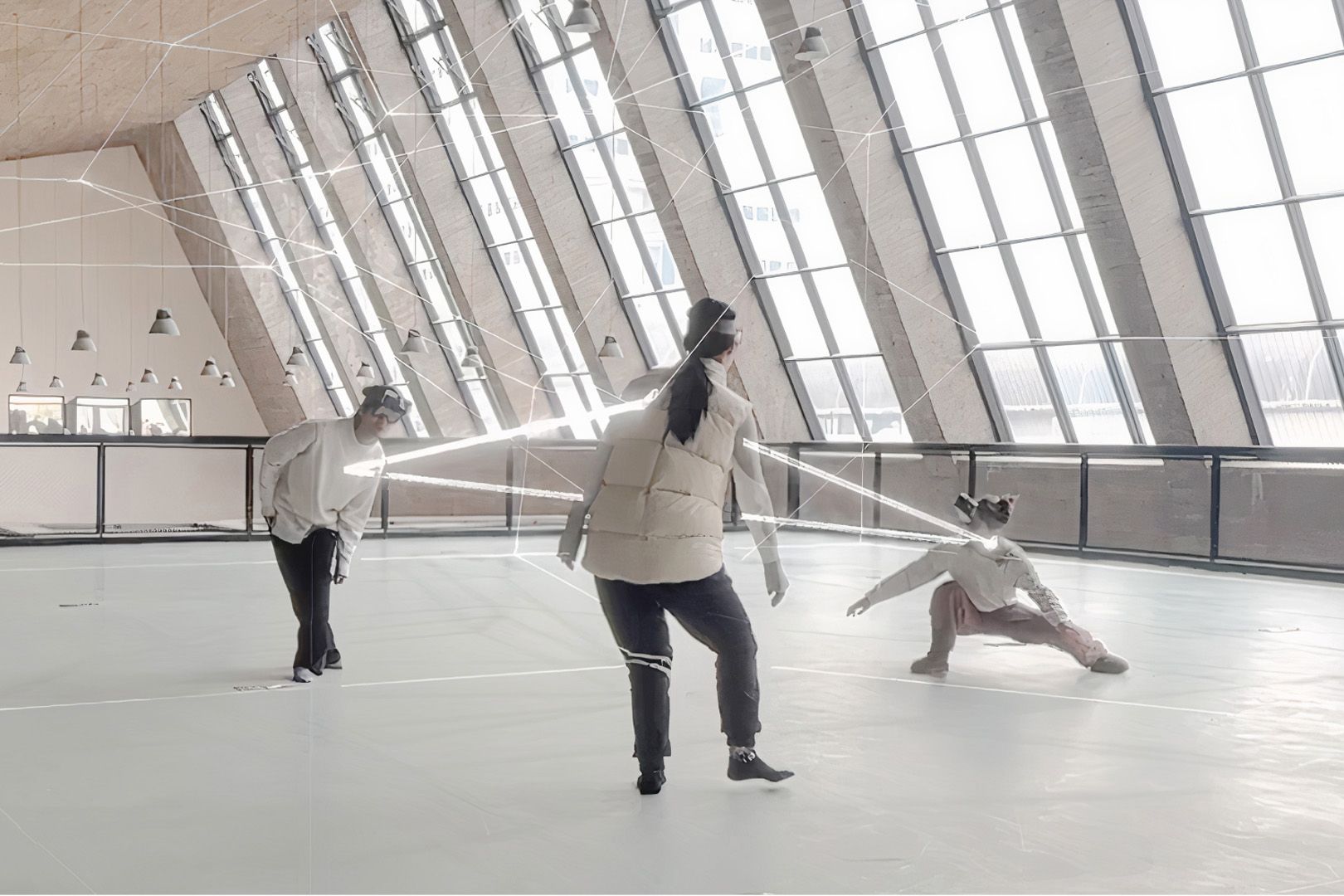“Cell Space: Augmented Awareness of Intercorporeality”
Conference:
Type(s):
Title:
- Cell Space: Augmented Awareness of Intercorporeality
Session/Category Title: Body & Bodies
Presenter(s)/Author(s):
Abstract:
Cell Space is an interactive art experience that integrates collocated augmented reality, neurofeedback, and contact improvisation, challenging the conventional boundaries between audience and performer, and blending the physical with the virtual, organic with technological. Inspired by McLuhan’s concept of media as an extension of the human body, and The AR Art Manifesto’s vision of “we becoming the Media,” this project reimagines participants as dynamic cells of a shared bio-digital ecosystem within the built environment. This immersive experience expands the concept of intercorporeality, moving beyond mere physical interaction to a shared bio-digital domain, thereby fostering a deeply interconnected environment of Human-Machine-Space Symbiosis. The paper contributes to the discourse on performing arts by presenting a new paradigm for applying AR and neurofeedback in contact improvisation, creating a new layer of perception and fostering intercorporeal interactions by reinforcing both individual and collaborative intentionality of its participants. Ultimately, Cell Space serves as a reflective mirror to the potential futures of our increasingly interconnected existence, encouraging participants to explore a transformative landscape that resonates with the complex interplay between their physical and digital identities and their surroundings.
References:
[1]
Franz Aurenhammer. 1987. Power diagrams: properties, algorithms and applications. SIAM J. Comput. 16, 1 (1987), 78–96.
Digital Library
Google Scholar
[2]
Claire Bardainne. [n. d.]. Mondot. A.(sf): Adrien M & Claire B. AM & CB. https://www. am-cb. net/en ([n. d.]).
Google Scholar
[3]
Thomas J Csordas. 2008. Intersubjectivity and intercorporeality. Subjectivity 22 (2008), 110–121.
Crossref
Google Scholar
[4]
John M Culkin. 1967. A schoolman’s guide to Marshall McLuhan.
Google Scholar
[5]
John Desnoyers-Stewart, Ekaterina R Stepanova, Bernhard E Riecke, and Patrick Pennefather. 2020. Body RemiXer: extending bodies to stimulate social connection in an immersive installation. In ACM SIGGRAPH 2020 Art Gallery. 394–400.
Digital Library
Google Scholar
[6]
Kristin Feireiss, G?nther Feuerstein, Thom Mayne, et al. 2022. Out of the Clouds: Wolf dPrix: Sketches 1967–2020. Birkh?user.
Google Scholar
[7]
Flowtime. 2024. Flowtime: Biosensing Meditation Headband. https://www.meetflowtime.com/ [Accessed: 2024-01-11].
Google Scholar
[8]
Inc. Flowtime. 2023. Flowtime SDK. https://developer.entertech.cn/
Google Scholar
[9]
Donna Haraway. 2013. A cyborg manifesto: Science, technology, and socialist-feminism in the late twentieth century. In The transgender studies reader. Routledge, 103–118.
Google Scholar
[10]
Donna J Haraway. 2000. A cyborg manifesto: Science, technology, and socialist-feminism in the late twentieth century. In Posthumanism. Springer, 69–84.
Crossref
Google Scholar
[11]
Ali Hossaini, Oliver Gingrich, Shama Rahman, Mick Grierson, Joshua Murr, Alan Chamberlain, and Alain Renaud. 2022. GROUPTHINK: telepresence and agency during Live performance. Proceedings of the ACM on Computer Graphics and Interactive Techniques 5, 4 (2022), 1–10.
Digital Library
Google Scholar
[12]
Botao Hu, Yuchen Zhang, Sizheng Hao, and Yilan Tao. 2023. InstantCopresence: A Spatial Anchor Sharing Methodology for Co-located Multiplayer Handheld and Headworn AR. In 2023 IEEE International Symposium on Mixed and Augmented Reality Adjunct (ISMAR-Adjunct). IEEE, Sydney, Australia, 762–763. https://doi.org/10.1109/ISMAR-Adjunct60411.2023.00165
Crossref
Google Scholar
[13]
Holo Interactive. 2024. Holokit X: Open source mixed reality headset for creative coding. https://holokit.io/ [Accessed: 2024-01-11].
Google Scholar
[14]
David Koteen, Nancy Stark Smith, and Steve Paxton. 2008. Caught falling: the confluence of contact improvisation, Nancy Stark Smith, and other moving ideas. Contact Editions.
Google Scholar
[15]
Lev Manovich. 2010. The poetics of augmented space. In Mediatecture. Springer, 304–318.
Google Scholar
[16]
Marshall McLuhan. 1994. Understanding media: The extensions of man. MIT press.
Google Scholar
[17]
Anton Nijholt. 2019. Introduction: brain-computer interfaces for artistic expression. Brain Art: Brain-Computer Interfaces for Artistic Expression (2019), 1–29.
Google Scholar
[18]
Esen G?k?e ?zdamar. 2019. An architectural counterpoint in Universal Everything: Fluid Bodies exhibition. Digital Creativity 30, 3 (2019), 206–212.
Crossref
Google Scholar
[19]
Jess Rowland. 2021. Perception as Media: Reconsidering the Arts and Neurotechnology. Leonardo 54, 4 (2021), 406–411.
Crossref
Google Scholar
[20]
Chris H. Rycroft. 2009. VORO++: A three-dimensional Voronoi cell library in C++. Chaos: An Interdisciplinary Journal of Nonlinear Science 19, 4 (Dec. 2009), 041111. https://doi.org/10.1063/1.3215722
Crossref
Google Scholar
[21]
John R Searle. 1983. Intentionality: An essay in the philosophy of mind. Cambridge university press.
Crossref
Google Scholar
[22]
Jennifer Siegal. 2002. Mobile: the art of portable architecture. Princeton Architectural Press.
Google Scholar
[23]
Shogo Tanaka. 2015. Intercorporeality as a theory of social cognition. Theory & psychology 25, 4 (2015), 455–472.
Google Scholar
[24]
David Ruiz Torres. 2016. AR Art Manifesto. MATERIA 19 (2016).
Google Scholar
[25]
Polina Zioga, Paul Chapman, Minhua Ma, and Frank Pollick. 2017. Enheduanna–A Manifesto of Falling: first demonstration of a live brain-computer cinema performance with multi-brain BCI interaction for one performer and two audience members. Digital Creativity 28, 2 (2017), 103–122.
Crossref
Google Scholar





